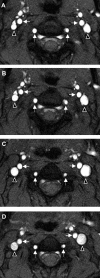Effects of short-term exposure to head-down tilt on cerebral hemodynamics: a prospective evaluation of a spaceflight analog using phase-contrast MRI
- PMID: 27013606
- PMCID: PMC4909835
- DOI: 10.1152/japplphysiol.00841.2015
Effects of short-term exposure to head-down tilt on cerebral hemodynamics: a prospective evaluation of a spaceflight analog using phase-contrast MRI
Abstract
Alterations in cerebral hemodynamics in microgravity are hypothesized to occur during spaceflight and could be linked to the Visual Impairment and Intracranial Pressure syndrome. Head-down tilt (HDT) is frequently used as a ground-based analog to simulate cephalad fluid shifts in microgravity; however, its effects on cerebral hemodynamics have not been well studied with MRI techniques. Here, we evaluate the effects of 1) various HDT angles on cerebral arterial and venous hemodynamics; and 2) exposure to 1% CO2 during an intermediate HDT angle (-12°) as an additional space-related environmental factor. Blood flow, cross-sectional area (CSA), and blood flow velocity were measured with phase-contrast MRI in the internal jugular veins, as well as the vertebral and internal carotid arteries. Nine healthy male subjects were measured at baseline (supine, 0°) and after 4.5 h of HDT at -6°, -12° (with and without 1% CO2), and -18°. We found a decrease in total arterial blood flow from baseline during all angles of HDT. On the venous side, CSA increased with HDT, and outflow decreased during -12° HDT (P = 0.039). Moreover, the addition of 1% CO2 to -12° HDT caused an increase in total arterial blood flow (P = 0.016) and jugular venous outflow (P < 0.001) compared with -12° HDT with ambient atmosphere. Overall, the results indicate decreased cerebral blood flow during HDT, which may have implications for microgravity-induced cerebral hemodynamic changes.
Keywords: MRI; cerebral blood flow; head-down tilt; microgravity; visual impairment and intracranial pressure.
Copyright © 2016 the American Physiological Society.
Figures




Similar articles
-
Internal Jugular Vein Volume During Head-Down Tilt and Carbon Dioxide Exposure in the SPACECOT Study.Aerosp Med Hum Perform. 2018 Apr 1;89(4):351-356. doi: 10.3357/AMHP.4934.2018. Aerosp Med Hum Perform. 2018. PMID: 29562964
-
Lower-body negative pressure decreases noninvasively measured intracranial pressure and internal jugular vein cross-sectional area during head-down tilt.J Appl Physiol (1985). 2017 Jul 1;123(1):260-266. doi: 10.1152/japplphysiol.00091.2017. Epub 2017 May 11. J Appl Physiol (1985). 2017. PMID: 28495841 Free PMC article.
-
Quantitative MRI volumetry, diffusivity, cerebrovascular flow, and cranial hydrodynamics during head-down tilt and hypercapnia: the SPACECOT study.J Appl Physiol (1985). 2017 May 1;122(5):1155-1166. doi: 10.1152/japplphysiol.00887.2016. Epub 2017 Feb 16. J Appl Physiol (1985). 2017. PMID: 28209740 Clinical Trial.
-
Analogs of microgravity: head-down tilt and water immersion.J Appl Physiol (1985). 2016 Apr 15;120(8):904-14. doi: 10.1152/japplphysiol.00986.2015. Epub 2016 Feb 11. J Appl Physiol (1985). 2016. PMID: 26869710 Review.
-
Postural influence on intracranial fluid dynamics: an overview.J Physiol Anthropol. 2023 Apr 13;42(1):5. doi: 10.1186/s40101-023-00323-6. J Physiol Anthropol. 2023. PMID: 37055862 Free PMC article. Review.
Cited by
-
Spaceflight associated neuro-ocular syndrome (SANS) and the neuro-ophthalmologic effects of microgravity: a review and an update.NPJ Microgravity. 2020 Feb 7;6:7. doi: 10.1038/s41526-020-0097-9. eCollection 2020. NPJ Microgravity. 2020. PMID: 32047839 Free PMC article. Review.
-
Quantification of arterial, venous, and cerebrospinal fluid flow dynamics by magnetic resonance imaging under simulated micro-gravity conditions: a prospective cohort study.Fluids Barriers CNS. 2021 Feb 12;18(1):8. doi: 10.1186/s12987-021-00238-3. Fluids Barriers CNS. 2021. PMID: 33579319 Free PMC article.
-
Jugular venous flow dynamics during acute weightlessness.J Appl Physiol (1985). 2024 May 1;136(5):1105-1112. doi: 10.1152/japplphysiol.00384.2023. Epub 2024 Mar 14. J Appl Physiol (1985). 2024. PMID: 38482574 Free PMC article.
-
MRI-derived diffusion parameters in the human optic nerve and its surrounding sheath during head-down tilt.NPJ Microgravity. 2017 Jun 21;3:18. doi: 10.1038/s41526-017-0023-y. eCollection 2017. NPJ Microgravity. 2017. PMID: 28649640 Free PMC article.
-
The impact of a short-period head-down tilt on executive function in younger adults.Sci Rep. 2022 Dec 3;12(1):20888. doi: 10.1038/s41598-022-25123-3. Sci Rep. 2022. PMID: 36463320 Free PMC article.
References
-
- Alperin N, Lee SH, Sivaramakrishnan A, Hushek SG. Quantifying the effect of posture on intracranial physiology in humans by MRI flow studies. J Magn Reson Imaging 22: 591–596, 2005. - PubMed
-
- Arbeille P, Fomina G, Roumy J, Alferova I, Tobal N, Herault S. Adaptation of the left heart, cerebral and femoral arteries, and jugular and femoral veins during short- and long-term head-down tilt and spaceflights. Eur J Appl Physiol 86: 157–168, 2001. - PubMed
-
- Arbeille P, Provost R, Zuj K, Vincent N. Measurements of jugular, portal, femoral, and calf vein cross-sectional area for the assessment of venous blood redistribution with long duration spaceflight (Vessel Imaging Experiment). Eur J Appl Physiol 115: 2099–2106, 2015. - PubMed
-
- Bagian JP, Hackett P. Cerebral blood flow: comparison of ground-based and spaceflight data and correlation with space adaptation syndrome. J Clin Pharmacol 31: 1036–1040, 1991. - PubMed
-
- Balédent O, Henry-Feugeas MC, Idy-Peretti I. Cerebrospinal fluid dynamics and relation with blood flow: a magnetic resonance study with semiautomated cerebrospinal fluid segmentation. Invest Radiol 36: 368–377, 2001. - PubMed
Publication types
MeSH terms
LinkOut - more resources
Full Text Sources
Other Literature Sources

